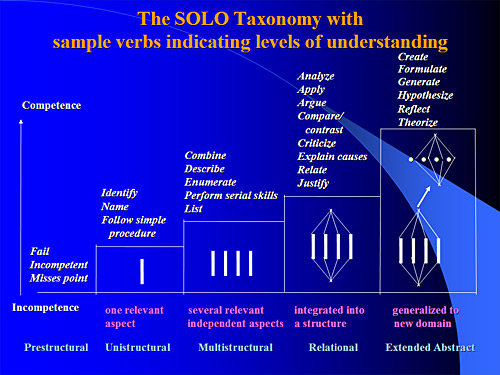 |  | ||
Solo Taxonomy has been sitting on my to-do list for a while. Dean Groom, during his presentation at MICDS, reminded me and I took a little time to have a play with it. SOLO stands for Structure of Observed Learning Outcomes. It was developed in 1982 by John B. Biggs and Kelvin Collis. It is essentially a hierarchy which has 5 stages or levels that attempts to assess the students learning based on the quality of their work. A more detailed description is posted below—check it out! posted by Andrew Churches | |||
SOLO Taxonomy
Do you like this story?
SOLO stands for Structure of Observed Learning Outcomes. Like Bloom’s taxonomy it looks and structures many of the key verbs used in assessment into different levels.

Source: http://www.johnbiggs.com.au/solo_graph.html
Prestructural – Lower Order
Students acquires unconnected information. The information is not organised amd makes no sense.

UniStructural
Simple connections are created between ideas. Connections are obvious—Keywords: Identify, Name

MultiStructural
More connections are being created, but lacks the meta-connections between them—Keywords: combine, describe, list, order

Relational
Student sees the significence of the various pieces of information and can develop relationships between them—Keywords:Analyse, apply, argue, debate, compare, contrast, check, judge, critique, explain, moderate, relate, integrate, justify

Extended Abstract
Can make connections beyond the probable. Can generalize and apply to new situation. Can transfer learning and make links between subject areas—Keywords: Reflect, evaluate, create, hypothesize, design, invent, conceptualize, theorize, project, abstract

We want to have our students working at the highest levels of extended abstract, where they can make relationships that stretch beyond the bounds of the discipline or subject area, and can be applied in a variety of situations.

Solo Taxonomy shares similarities with the Modified Daggett’s Application Model, where the higher levels of learning are achieved when learning is applied in real world unpredicatable situations, rather than just applying it to studies within a single unit of learning.


No comments:
Post a Comment